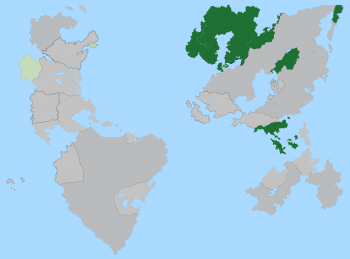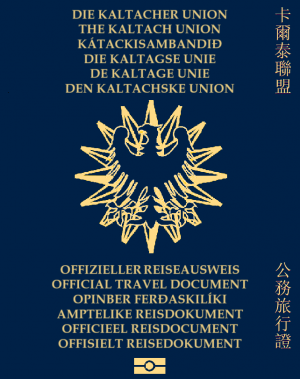Kaltach Union
Kaltach Union | |
|---|---|
|
Flag | |
| Anthem: "Kaltachian Meadows" | |
 Full and honourary members of the Kaltach Union outlined in dark green, associate members in light green | |
| Institutional seats | Schwannburg
Old Konigstadt
Fujing
|
| Largest metropolis | Fujing |
| Official languages | 7 official languages, working languages in bold
|
| Demonym(s) | Kaltach |
| Type | Supranational geopolitical-cultural union |
| Membership | 13 member states and territories, associate members not bolded |
| Government | Intergovernmental |
• KU Presidency | |
• KU President | |
• KU Congressional Head | |
| Legislature | Kaltach Congress |
| Establishment | |
| June 4, 1974 CE | |
• Last member (Welka) admitted | December 24, 1991 CE |
| Population | |
• 2015 estimate | 955,491,805 |
| Currency | |
| Internet TLD | .ku is representative of the whole of the KU; member states also have their own TLDs. |
The Kaltach Union (KU; Kanadiaans: Kaltacher Union, Trefjalli: Kátackisambandið), also called the New Kaltach Union to differentiate it from the Kaltach Union of antiquity when necessary, is a political and economic union open to any democratic and free Kaltach nation or any nation with a significant Kaltach minority. It exists to promote cultural, economic, military, and political ties between Kaltach nations. Full members and honourary members of the KU must respect universal Kaltach principles such as democracy, the rule of law, and accept the Kaltach Declaration of Rights and actively enforce it within their own nation.
The Kaltach Union was created as a joint venture between the Candanadian, Trefjalli, and Alpenraumisch governments in 1974 to promote inter-Kaltach cooperation, strengthen Kaltach ties, and promote Kaltach democracy following the reinstatement of democracy in Candanadium in 1967, with the Treaty of Schwannburg. It was created to promote universal Kaltach values across all Kaltach nations and to prevent Kaltach nations from succumbing to totalitarianism as well as to protect human rights across Kaltach nations. Full members and regional partners of the KU enjoy free trade with fellow KU members, and KU member nations also have relatively loose visa policies for citizens of fellow KU nations. The KU is headquartered in Schwannburg, Belkhomir, and sessions of the KU Congress, to which each nation sends a permanent representative, are held regularly to discuss the future of the alliance.
The original members of the KU included Candanadium, Belkhomir, Trefjall, Kreyermark, Jokullheim, Varskhomir, and Alpenraum. Akarea also expressed interest in joining, but Clause 3 of the Treaty of Schwannburg limits membership to "culturally Kaltach nation-states", a definition that Akarea traditionally did not fall under. However, due to its historic ties to the nations of Great Kaltachia, it was deemed inappropriate for Akarea to be only given associate member status. Thus, Akarea was made an honourary member of the KU, elevating it to a status on par with the full members of the Kaltach Union, being able to send voting delegates to the KU Congress and taking full advantage of KU-wide economic treaties. The only restriction placed upon it was that Akarea could not vote on issues relating to culture or language, due to its non-Kaltach cultural heritage.
Welka joined in 1991, following the collapse of communism in the nation. The two Candanadian autonomous regions are members in their own right due to their autonomous status, but by convention abstain from votes if they share the opinion of the Candanadian government as to not grant Candanadium two extra votes in the KU Congress. The KU Congress can pass directives, which are non-binding but must be recognized and responded to by member states, as well as regulations, which are binding. KU regulations are not binding in associate states unless ratified by their national legislatures, but they are nonetheless obliged to vote upon them domestically every time one is passed.
Associate members have a seat in the KU Congress and may speak on issues but not vote, and do not enjoy automatic free trade with KU nations. Some examples of joint KU ventures include the Kaltach Union Kanadiaans Cultural Committee (KUKCC), which runs the Kanadiaans Council, the Kaltach Union Trefjalli Cultural Committee (KUTCC), the Kaltach Union Joint Defence Program (KUJDP), and the Kaltach Economic Area. All current KU members and associate members are also members of the KU Joint Defence Program.
Currently, the Kaltach Union comprises of nine full members (Candandium, Caskhomir AR and Belkhomir AR in right of Candanadium, Alpenraum, Jokullheim, Kreyermark, Trefjall, Varskhomir, and Welka), one honourary member (Akarea), and three associate members (Satoyama, Alayka, and Drulluhus).
History
Background
Following the fall of the Old Kaltach Union, no clear successor organization or state emerged, leaving the Kaltach nations with no centralization. In the centuries that followed, the various Kaltach nations grew more distinct from each other, with the emergence of the Trefjalli as the first seafaring Kaltach nation, establishing the colony of Drulluhus as well as the penal colony of Jokullheim. The Kanadiaans, in their exile from the Isle of Kaltach, founded the Great Kingdoms in what is now Candanadium and the Southern Kingdoms in what is now Alpenraum, and came into contact with the Oseanians, a Trefjalli splinter group. The Kanadiaans displaced the Caskaans and Varskaans as the dominant Kaltach nation in western Great Kaltachia.
In the 18th century, following the end of the War of the Cask, a Kanadiaans-led pan-Kaltach movement called for the creation of a new Kaltach union, and with the establishment of the Kingdom of Candanadium to unite the Great Kingdoms and Oseania, many assumed that Candanadium would grow to encompass all the Kaltach nation-states of western Great Kaltachia. In anticipation of this, the founders of Candanadium envisioned it as a pan-Kaltach movement, creating it as a federation where culturally distinct provinces would retain the right to govern themselves to a large extent. However, with the arrival of Prophetism in the Southern Kingdoms and the creation of Alpenraum, the dream of a Candanadian-led Kaltach movement had seemingly been shattered.
In the years that followed, the Kaltach states grew closer in diplomatic ties as Kaltach peoples explored and colonized Edofasia and built closer ties to the Orient, with Kaltach sailors setting up Hautsing as a permanent base for contact with Akarea, Satoyama, and Hykko. Though no formal Kaltach organization existed, the Kaltach nations often met multilaterally to discuss foreign policy and acted in a largely cohesive manner. This was broken in 1908 with the establishment of the Welkan Democratic People's Republic, which broke off contact with the other Kaltach nations and pursued a policy of anti-imperialism and isolationism. The loss of Welka from the Kaltach bloc did not hinder progress much, as the remaining Kaltach states simply grew closer to each other. The rise of the True Northern Front in Candanadium led to tensions among the Kaltach bloc as Candanadium annexed Belkhomir in a bout of expansionism within Kaltachia itself. Though Kaltach domestic and foreign policy were no longer unified, Kaltach defence policy ultimately did not change due to Candanadium's status as the primary military power in Kaltachia as well as the support the TNF received from Alpenraum and Akarea. Other Kaltach nations like Drulluhus owed their prolonged independence to Candanadian and Kaltach intervention, and thus did not speak out against the TNF. Consequently, Kaltach nations like Trefjall, Caskhomir, and Jokullheim were forced to rally around Candanadium in the Tara Insurgencies and the Second Edofasian Crisis, as well as Akarea.
Following the reinstatement of democracy in Candanadium, the Kaltach bloc once again became much more intimate, with higher degrees of cooperation between the Kaltach states. It was argued by the post-TNF government that a Kaltach union was now once again necessary to prevent any Kaltach nation from making unilateral decisions on behalf of all of Kaltachia, as well as to promote cooperation, democracy, the rule of law, and human rights across Kaltachia. This was partly to counter the rising powers of the Terran Commonwealth, of which the now newly unified Edofasia was now a member, as well as to exert more pressure on Communist Welka so that Welka could be brought back into the fold.
The Kaltach Union was thus founded with the Treaty of Schwannburg in 1974, with all of its current members and associate members except Welka taking part. Alayka, with a sizable Kaltach minority population, sought participation in the KU as a means of ensuring its continued independence from both Novmir and Edofasia, emboldened by the Candanadian withdrawal from mainland Terra. The same reasoning applied to a degree to Drulluhus, which already had a significant Candanadian and Trefjalli military presence within its borders, but sought KU participation to safeguard against any future incursions upon its sovereignty. Both Alayka and Drulluhus were admitted as associate members and not full members to avoid an escalation of tensions with the TC. The last associate member, Satoyama, joined the KU out of its long-standing ties to both Akarea and Candanadium and enmity with Cenaesia, despite being culturally and ethnically foreign.
Welkan Accession to the Union
Following the Welkan popular movement deposed of the ruling communist government in 1991, Welka became a democratic, parliamentary republic and again aligned itself with the Kaltach Union, which provided it with much-needed direct investment as well as support in defence against the newly-formed theocratic state of Upharsin on the Welkan border and to ensure freedom of navigation across the narrow Cenaesian-Jazadoan straits.
Politics
KU Presidency
The KU Presidency rotates between the full and honourary members of the Kaltach Union. The head of that member nation's Kaltach Congressional Caucus then becomes the KU President and presides over the meetings of the various KU Committees and is responsible for briefing Kaltach heads of government on KU legislation and affairs. The KU President also chairs the annual KU summits between KU leaders.
Currently, the KU Presidency is held by Caskhomir, and the KU President is Erika de Jager, Head of the Caskhomir Kaltach Congressional Caucus.
KU Congress
KU Summits
KU summits between Kaltach heads of state and government are held annually, but extraordinary summits are sometimes held as situations emerge. The Kaltach Union Research Group (KURG) at the Kanadiaans University of New Konigstadt is the leading source for analysis of KU members' commitments to goals set down at KU summits and KU Congress directives, regulations, and standards.
KU Ventures and Committees
Member States
Common External Relations & Policies

Security and Defence
Trade
Humanitarian & Development Assistance
Symbols
Blue Eagle
The Kaltach Union uses the Blue Eagle, the sigil of the Old Kaltach Union as its official symbol and appears on the flag of the Kaltach Union.

